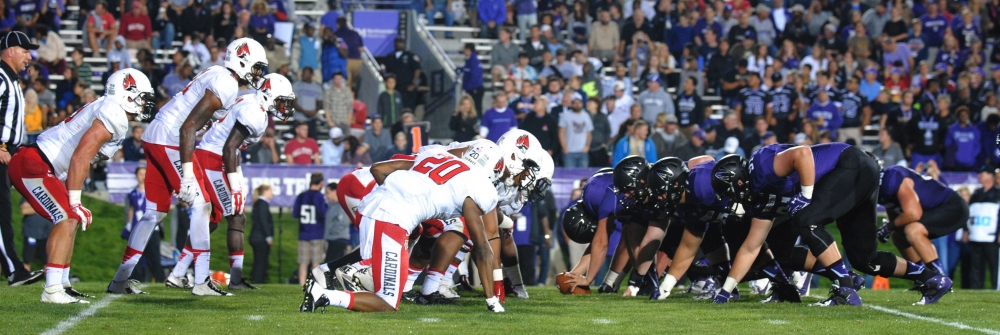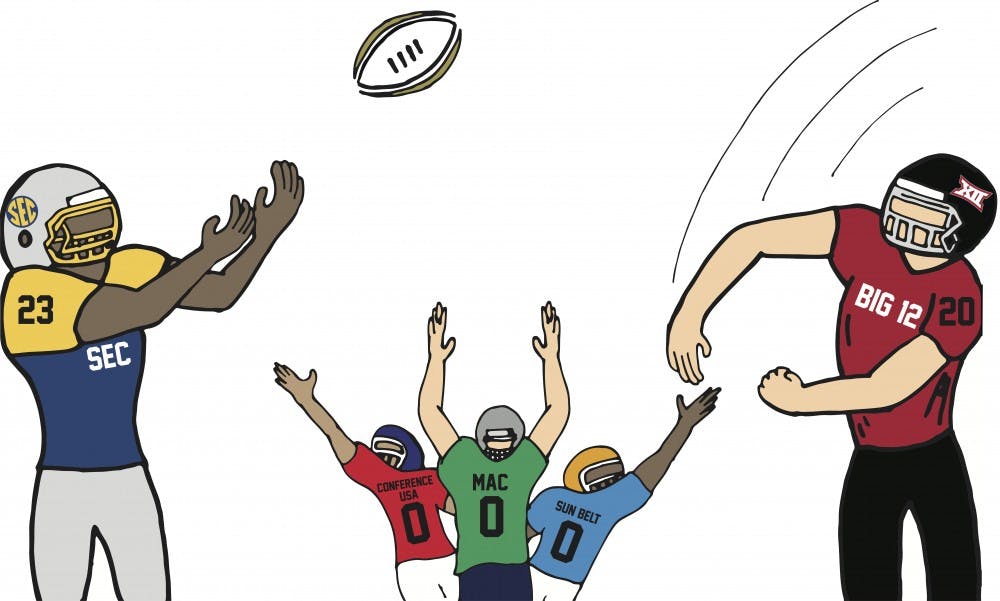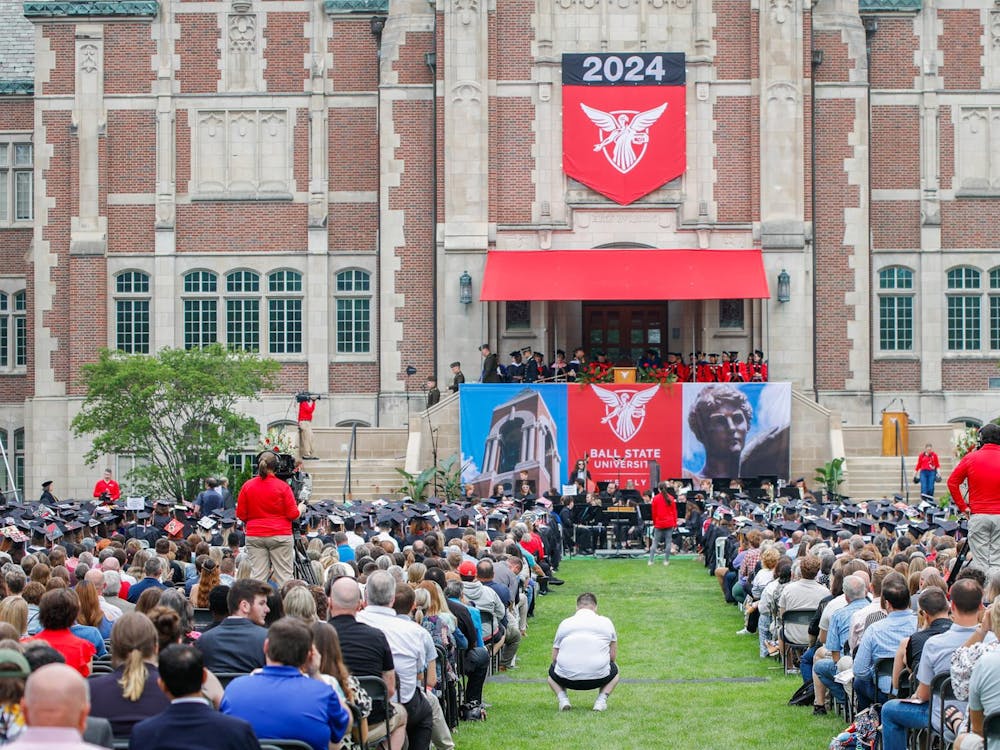Power Five All-Time Championships
This is a list of the most winningest college football conferences in terms of championship victories. These numbers start when the poll ear was introduced to Division-1 football in 1936.
Southeastern Conference - 23
Big 12 Conference - 20
Independents - 13
Big Ten Conference - 10
Atlantic Coastal Conference - 10
Pac 12 Conference - 10
In 2008, Ball State football went a perfect 12-0 in the regular season, launching itself into the conversation for a spot in one of the most coveted bowl games in college football: the Bowl Championship Series.
At the time, no Mid-American Conference school had ever played in a BCS game, and Ball State was riding high at No. 12 in the country, entering the conference championship game against a 7-5 Buffalo team.
While Ball State was the favorite entering the game, a single 42-24 loss dropped the Cardinals down 10 spots in the NCAA rankings and landed them a spot in the GMAC Bowl, where it lost to Tulsa by 32 points.
It is hard for mid-major schools to compare themselves with these Power Five goliaths, but reaching national prominence remains their goal.
“Most of what we enjoy most about Division I athletics is that we’re playing at the highest level,” Ball State Athletic Director Mark Sandy said. “We’re competing and aspiring to win our conference and compete nationally. … There’s much more power in the fact that you’re competing at the highest level in Division I.”
But playing in the highest division is not in the best interest of all mid-major schools.
Earlier this week, faculty and students at MAC member Eastern Michigan put together a financial sustainability report explaining why the program should no longer compete at the Division I level of college football.
The report was quickly shut down by Eastern Michigan’s interim president and MAC commissioner Jon Steinbrecher, who both said the program has no plans to go anywhere.
Sandy did not comment on the issues brought up in the report but knows that as a conference, the MAC remains in a good place.
“I don’t think you’re going to see a widespread move from being in the Mid-American Conference,” Sandy said. “The review of athletics revenues and expenditures is something that is going to continue.”
With schools like Eastern Michigan struggling to compete at the FBS level, other mid-major schools like Ball State are posed with a question: Is it worth it to move down in order to be more competitive at another level?
This issue has come to light as other football programs across the country have faced a similar decision.
The University of Idaho announced April 27 that it will drop out of the FBS in order to compete in the Football Championship Division, a lower subdivision of D-I athletics. This was a decision made after it received word in March that its conference, the Sun Belt, will drop from 12 to 10 teams beginning in 2018.
New Mexico State was the other team left out of the Sun Belt’s 10-team plan, but it has not made a decision on whether it will compete as an independent at the FBS level or drop down to the FCS.
“I think it hurts your image if you move down, but I think it’s the right decision in some instances because of location,” Sandy said. “Schools that are out in the southwest and in the west don’t have very many choices because those are the teams they can play.”
The University of Massachusetts, which has played in the MAC since 2012, recently became an independent school. UMass Faculty Senate met to discuss the end of FBS football at the school.
Daniel Malone, football beat reporter for MassLive.com, said the idea to drop FBS football was defeated by a non-binding vote count of 26 to 14 at the Faculty Senate meeting on April 28.
Lower-tier FBS schools could potentially be more competitive in the Football Championship Subdivision, but there are reasons why teams like Ball State and even Eastern Michigan decide to stay put. The benefits — national recognition, school pride and financing — outweigh the idea of being able to win a few more games at a lower level.
David Ridpath is an associate professor at Ohio University and has molded his career around issues in intercollegiate athletics. He said there’s a question that not enough programs are considering.
“Let’s be honest here, what are they really getting from playing [FBS]? I would argue they’re not really getting a whole lot,” Ridpath said. “Why should you be in a system where you can’t compete for a championship?”
Based on the previous Bowl Championship Series setup, Power Five schools automatically qualify into the top bowls — making it extremely difficult for mid-major schools to even make it into these games.
Even with the current College Football Playoff, it is still unlikely that a mid-major can make it into the top four. No mid-major school has ever won a national championship game.
In Eastern Michigan’s report, faculty member Howard Bunsis explained how Eastern Michigan is “fighting a losing battle that cannot be won” in terms of football. His colleague, Robert Carpenter, is the chair of the Faculty Senate Budget and Resources Committee and one of the members who put together the report.
“Schools in the MAC are sort of sandwiched in the middle. They have the aspiration to be one of the top-tier programs, but [they] don’t have the support for it,” Carpenter said. “They’re just caught in the middle there trying to decide what the identity is of the conference.”

A price to pay
An average college student may not understand the differences between college football subdivisions, but they’re affected by it.
Power Five schools have started a trend of getting television networks catered to their conferences — like the Big Ten Network and SEC Network — which has built revenues at their institutions and made it even harder for mid-major schools to keep up.
“The only way [conference revenue] is going to get closer over the next 10-20 years is if the revenue is decreased from the [Power Five] side,” Sandy said. “It’s not going to get increased drastically from [the mid-major] side.”
Historically, many athletic departments require subsidies, or money from other sources, to remain in the green.
Mid-major schools have used a variety of tactics to try to balance their budgets; a majority of its cash flow comes student service fees.
According to the 2015-16 tuition and fees term sheet, Ball State students who take more than 7 credit hours in a semester pay $647 for these fees per semester and $1,294 in a year. The student service fee fund made up more than $13 million — over half — of the Ball State athletic budget last year.
Cutting down these service fees was the main goal for Eastern Michigan treasurer Howard Bunsis, who has seen cuts in the school’s academics, not athletics.
“Students are struggling so much financially today, … we need to do everything we can to try and better these students,” Bunsis said. “Diverting costs to athletic programs that are not going to succeed financially doesn’t make sense. You can still have all the great things that athletics brings to an individual and the institution, just at a much lower cost.”
Eastern Michigan’s athletic budget has been at least 80 percent subsidized each of the past 10 years.
According to USA Today, some Division I athletic programs had as much as 90 percent of their athletic budgets subsidized last season.
It’s numbers like these that are concerning for Ridpath, who has seen these numbers grow over time.
“It will get to a point where schools like Ball State or Ohio will absolutely not be able to support it,” Ridpath said. “It’s going to collapse on itself. The system cannot sustain it. I would rather be proactive and do something. … Unfortunately, I don’t think that is going to happen.”
Only 12 athletic programs — all Power Five schools — from the FBS and FCS combined didn’t subsidize their programs in the 2014-15 season, according to USA Today.

Ball State subsidized more than 75 percent of its athletic budget in 2015.In addition to the student service fee, one of the biggest payouts for mid-major schools each year is labeled in the budget as “Guarantees.”
Around $1.9 million of Ball State’s 2015-16 Auxiliary Fund Budget for Intercollegiate Athletics came from guarantee games, like its game against Texas A&M last season. Guarantee games are a process where Power Five schools pay smaller schools to play them.
When a Power Five school pays a mid-major to come to their house and play, they’re supposed to win. But on occasion, these games won’t go the way the bigger schools want, and mid-majors can walk away with victory and a cash payout.
The pride of Division I
Last season, each of the Mid-American Conference’s 13 members played at least one Power Five institution. Bowling Green and Toledo earned two wins apiece, but the league as a whole went 4-18, losing by an average of 12 points.
MAC teams have had success in regular seasons’ past, but so far it hasn’t translated to the postseason.
In 2013, Northern Illinois became the first MAC school to receive a BCS bid. The Huskies were ranked No. 15 nationally with a 12-0 record going into the game.
Northern Illinois lost to Florida State in the Orange Bowl 31-10.
Sandy admitted that even now it would be “very hard” for a mid-major school to win one of college football's most coveted bowl games, although Boise State has won multiple BCS bowl games while in a mid-major conference.
“I think it’s going to be very hard, because the space between [the Power Five and mid-majors] has gotten larger because of the money,” Sandy said. “I think it’s possible to be a Boise State and to get out there and do that, but it’s very difficult. So I don’t see it happening very often.”
Only a handful of teams outside of the Power Five and Notre Dame, an FBS independent, have made it to a BCS bowl.
Even fewer have won one.

In the past two seasons, Ball State has shown it can keep it close against bigger opponents like Iowa and Northwestern.But Ball State also took a 56-23 loss at Texas A&M last season, a game that the Aggies led 49-3 at halftime.
And that wasn’t even the biggest blowout a MAC school faced in 2015.
Akron lost to Oklahoma 41-3, Kent State lost to Illinois 52-3, and the biggest loss of the season came when Wisconsin shut out Miami 58-0.
Blowout losses like these are the reason why Ridpath, who spent a number of years at FCS affiliate Weber State, thinks some schools should consider moving down.
“It’s very competitive, but it’s also very exciting,” Ridpath said. “What was great about when I worked for Weber State was that it was in a division where it could also compete for a national championship.”
Weber State is a member of the Big Sky, the same conference Idaho will re-join since it chose to drop to a lower subdivision.
While Weber State only went 6-5 last season, it beat a top-25 opponent and came within 1 point of Eastern Washington, which was ranked No. 2 in the country at the time.
Weber State also stood its ground with both Ball State and Eastern Michigan in home attendance numbers, averaging 6,500 throughout the year.
In 2015, Eastern Michigan and Ball State had the lowest home attendance numbers in all of the FBS. They were the only two schools to average under 10,000 fans per game, Ball State with 8,000 per game and Eastern Michigan at 5,000.
These low attendance numbers were not always the case for Ball State. During its 2008 campaign, Ball State had four of its highest-attended home games ever at Scheumann Stadium, which included more than 11,000 students and nearly 24,000 fans at the season finale.
|
|
|
|
Attendance as a whole at the FCS level increased from last season. Ridpath believes it brings in a more passionate fan base because they don’t try to compete with super power teams like those in the Power Five.
“That’s exciting. Stay in your lane and realize who you are, rather than saying that [FBS] football is so incredibly important to the image of the university,” Ridpath said. “ I would argue that most students don’t care.”
While Sandy said a lot of programs aspire to move up to the FBS level, a former Ball State football coach has a different idea.
Pete Lembo is now an assistant coach at Maryland. Prior to his jobs with the Cardinals and Terrapins, he spent 10 years as an FCS head coach at Lehigh and Elon. He said there are a lot of FCS programs that are happy where they are.
“The most important thing is giving yourself a chance to be successful consistently,” Lembo said. “There are some institutions that are very happy [in the FCS]. And I feel like what they’re doing, they’re doing very well.”
National recognition
There are several reasons why Ball State and other mid-major schools won’t be leaving the FBS anytime soon, some of the largest reasons include television exposure and bowl game appearances.
Of the 128 FBS schools, 80 earned a bid to a bowl last season. These nationally televised games provide additional revenue for participating schools and conferences.
“For that one game, you get more publicity than you would in the FCS playoffs, unless you’re in the national championship game,” Sandy said.
In the 2014 GoDaddy Bowl, Ball State’s game against Arkansas State was aired on ESPN and was the team’s highest attendance of that season with over 36,000 fans.
On Election Night in 2012, Ball State took on MAC rival Toledo, which was No. 23 in the nation.
More than 2 million viewers tuned in that night to watch the Cardinals. The score was tied at 27 when Ball State got possession of the ball at its own 14-yard line.
An 11-play, 86-yard drive was capped off by a 15-yard touchdown run by Jahwan Edwards, leading Ball State to a 34-27 victory.
Listen to the radio call of Edwards touchdown run, audio provided by ballstatesports.com.

“That was a three-hour commercial for Ball State,” Lembo said. “For the next 48 hours, Ball State was on ESPN’s ticker for having knocked off a nationally ranked team.
“That’s just not going to happen if you’re in the FCS. … The size, resources, support and exposure that comes along with it is even greater in the FBS.”
The MAC may not have its own television network, but it does have a recent network deal with ESPN that will extend until the end of the 2026-27 athletic seasons.
National recognition that comes with Division I football plays into recruiting students as well as student-athletes.
While athletics are not the reason many students come to Ball State, Sandy said it certainly helps.
“It’s one of the reasons. People choose a school that is well known for athletics because it helps the [school’s] reputation,” he said.
Unlike the problems that Idaho and New Mexico deal with by being away from the rest of their conference, Ball State is in a central location in the MAC.
The benefits of playing in the MAC and staying an FBS school outweigh the negatives for most schools, keeping Ball State, who doesn’t have to deal with proximity issues with the rest of the MAC, and others at the highest level of college football.
“The geographic proximity that [MAC schools] have to each other helps keep the travel costs more modest,” Lembo said. “Of course, the exposure on ESPN has been very beneficial as well. … [Ball State’s] name is very visible.”
|
Power Five All-Time Championships This is a list of the most winningest college football conferences in terms of championship victories. These numbers start when the poll ear was introduced to Division-1 football in 1936. Southeastern Conference - 23 Big 12 Conference - 20 Independents - 13 Big Ten Conference - 10 Atlantic Coastal Conference - 10 Pac 12 Conference - 10 |





